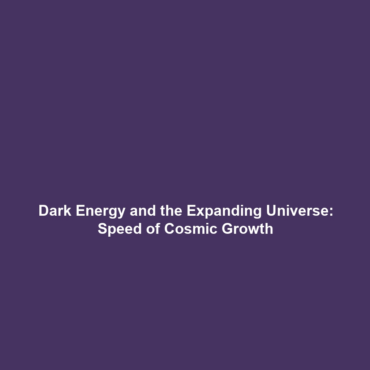Exploring Subtopics within Dark Matter and Dark Energy
Dark matter and dark energy represent two of the most profound mysteries in modern astrophysics. The various subtopics, including theoretical frameworks, experimental approaches, and computational models, profoundly influence our understanding of these concepts. The significance of studying these subtopics lies in their potential to unlock new realms of knowledge, helping to elucidate the very fabric of our universe. As scientists delve deeper into dark matter and dark energy, understanding these subtopics becomes essential for making groundbreaking discoveries.
Key Concepts
In the exploration of dark matter and dark energy, several key concepts arise from the study of subtopics. These concepts help establish how various aspects fit into this astrophysical context:
Subtopic 1: Theoretical Frameworks
Theoretical frameworks are crucial for interpreting dark matter’s role in cosmic structures and dark energy’s influence on the universe’s expansion. These frameworks encompass models like the Lambda Cold Dark Matter (ΛCDM) model, which integrates several subtopics such as gravitational lensing and cosmic microwave background radiation.
Subtopic 2: Experimental Approaches
Experimental approaches involve utilizing particle accelerators and underground laboratories to detect dark matter particles. These efforts are pivotal for validating theoretical predictions and bridging gaps in our understanding, highlighting the importance of collaboration across multiple disciplines within subtopics.
Subtopic 3: Computational Models
Recent advancements in computational modeling have enabled scientists to simulate large-scale structures in the universe. These subtopics allow researchers to visualize dark matter and dark energy interactions, leading to deeper insights.
Applications and Real-World Uses
Understanding subtopics related to dark matter and dark energy has practical implications across various domains:
- Astroengineering: Harnessing insights from dark energy can inform the design of future space exploration missions.
- Particle Physics: The search for dark matter influences research and development in particle detection technologies.
- Cosmology: The study of cosmic evolution is enhanced through applications of theoretical subtopics, aiding in space model validations.
Current Challenges
Studying subtopics within dark matter and dark energy presents several challenges, including:
- Challenges of Detection: Current technologies may be insufficient to detect dark matter particles directly.
- Theoretical Discrepancies: Competing theories around dark energy lead to confusion and debate within the scientific community.
- Data Interpretation Issues: The complexity of data from various experiments complicates our understanding of dark matter’s properties.
Future Research and Innovations
The future of research in dark matter and dark energy is promising, with several potential innovations on the horizon:
- Next-Gen Particle Detectors: Enhanced technologies may allow for unprecedented detection capabilities of dark matter particles.
- Advanced Computational Techniques: Improved simulations could enable deeper exploration of cosmic phenomena that involve dark matter and dark energy.
Conclusion
In summary, understanding subtopics within dark matter and dark energy is essential for unlocking the mysteries of the universe. From theoretical frameworks to innovative experimental approaches, the implications of these subtopics are profound and far-reaching. As researchers continue to confront the associated challenges and embrace future innovations, it becomes increasingly critical for individuals interested in astrophysics to stay informed and engaged. For more insights into related topics, visit our articles on theories of dark matter and the expansion of the universe.

